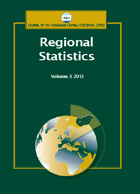How coronavirus spread in Europe over time: national probabilities based on migration networks
How coronavirus spread in Europe over time: national probabilities based on migration networks
Author(s): Áron Kincses, Géza TóthSubject(s): Social Sciences, Economy, Geography, Regional studies
Published by: Központi Statisztikai Hivatal
Keywords: international migration; migration networks; coronavirus
Summary/Abstract: Global migration trends (Hatton−Williamson 2005, Bálint et al 2017, Farkas–Dövényi 2018) today differ from those in previous centuries in terms of both the number of people migrating (as of 2017, 272 million people live in a country other than their country of origin) as well as the geographical, economic, and cultural distance between sending regions and destination countries. The interconnection between countries is constantly growing, relationships are expanding through migration, and people's movement is increasing. Migration shows strong territorial concentration (Winders 2014); in 2019, half of the global migrant population lived in nine countries. In international migration, there are centres (large host countries) and global migration destinations, which attract migrants over long distances. Such hubs include the USA, Canada, Australia, the UK, Germany, France and Spain. Close migration relationships mean strong exposure and vulnerability to the spread of infectious diseases. The calculation does not assume that infection can only be caused by migration, but states that migration relationships between countries, that is, their network, well represent the spread of infections between countries.
Journal: Regional Statistics
- Issue Year: 10/2020
- Issue No: 02
- Page Range: 228-231
- Page Count: 4
- Language: English

